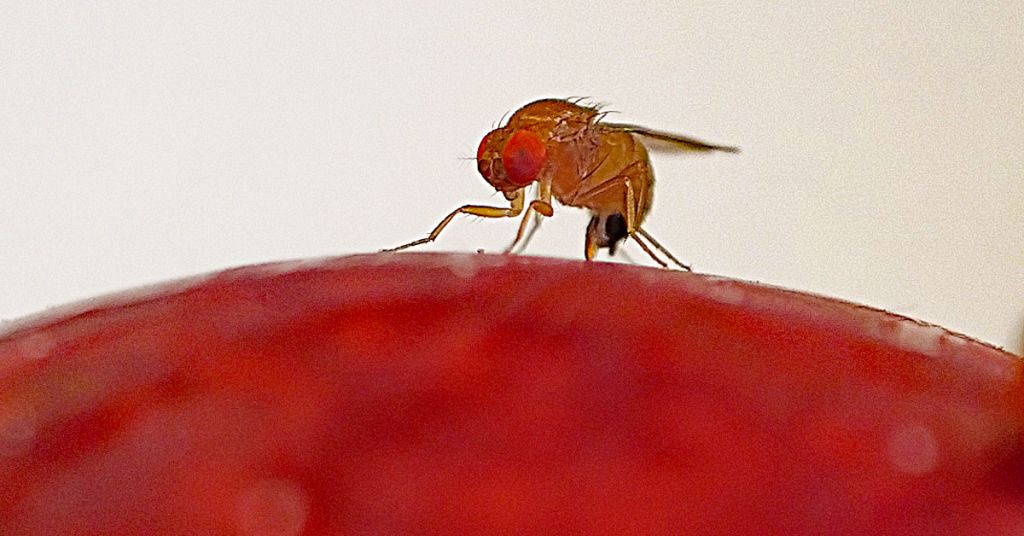By Valerie Brown. Pesticides, like onions, can come back to haunt you. This recently happened in some Hood River basin waters. The Environmental Protection Agency (EPA) proposed, this year, to list five creeks as ‘impaired waters’ under the Clean Water Act.
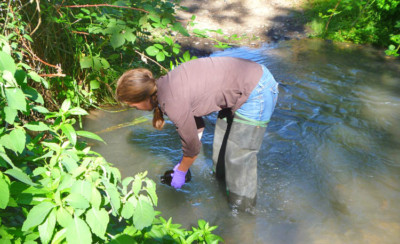
Water quality testing by Hood River Soil and Water Conservation District staff in Hood River County creeks. Photo credit: Hood River Soil and Water Conservation District
But experts who monitor pesticides in the basin’s waters stress that the EPA based its proposal on measurements only up to 2014. Recent rounds of sampling show declines in certain pesticides in certain streams, the decline due, in large part, to community efforts. Even though this is good news, the pesticides regulated by the EPA in the Hood River basin represent only a subset of the pesticides being used in the region. And pesticides are only a subset of all the chemicals present in the waters, which, among other harmful substances, includes: pharmaceuticals, flame retardants, industrial chemicals and ammonia.
Something Old, Something New, Something Toxic
The Clean Water Act regulates pollution in the nation’s waterways: rivers, lakes, creeks, wetlands, as well as drinking water. The law’s Section 303(d) requires states to submit a list of impaired waters. That’s where agriculture comes in, because ag uses a range of pesticides to kill off insects that harm crops. Many of these chemicals get into the waters through various means, like runoff and spray drift. Some are short-lived and others like DDT are toxic for decades. EPA sets standards on what pesticide levels in waters harm fish, invertebrates and humans.
Most of the pesticides the EPA wants to list are old: DDT, banned in 1972; dieldrin, banned in 1987; and heptachlor (banned in 1988 for everything but fire ants) in buried electrical transformers. Numerous waters in the Hood River drainage and other parts of Oregon have been 303(d) listed for these pesticides for decades, so these new proposed listings mostly represent water bodies that had not been previously tested: Indian Creek, Lenz Creek, Odell Creek, Mill Creek, and Threemile Creek. Two Gorge-area waters have also been proposed for listing by the EPA for the current-use pesticides chlorpyrifos and malathion: Odell Creek for the former and Threemile Creek for both.

[/media-credit] Lead arsenic spray on orchard circa 1915. Photo from the Collection of the History Museum of Hood River County.
The old chemicals, known as ‘legacy’ pesticides, collect in the sediments in streambeds. DDT, its breakdown products DDD and DDE, heptachlor epoxide, and dieldrin are bioaccumulative organochlorine compounds. Big words meaning the chemicals increase in each organism up the food chain. By the time we get to those high on the chain—humans or bears—eating salmon, there could be quite a body burden in the fish and that is transferred to whoever or whatever eats the fish.
The newer pesticides, malathion and chlorpyrifos are organophosphate insecticides, break down more quickly than organochlorines and don’t bioaccumulate. Both attack the nervous system. Chronic prenatal chlorpyrifos exposure can lower a child’s intelligence. In fact, chlorpyrifos is so universally regarded as toxic that the EPA, were it not for Donald Trump’s election, would have withdrawn the registration nationally for chlorpyrifos, but this decision was abandoned by EPA head Scott Pruitt this March 29.
Evidence from animal studies indicates that malathion may be a carcinogen. It has been in common use in agriculture since the 1950s and is considered an important mosquito control agent, but it breaks down in water into a significantly more toxic compound.
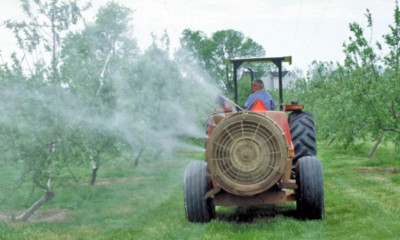
Fall spraying in Gorge orchards occurs after harvest often includes sulfur, mineral oil, nutrients, and other sprays. Photo Credit: HRSWCSD
All of these insecticides—DDT, DDD, DDE, dieldrin, malathion, and chlorpyrifos—are endocrine disrupters, which means they may adversely affect processes in the body controlled by hormones. Most often they interfere with reproductive hormones and the thyroid system, both of which can in turn wreak havoc on developmental processes.
Of course, there is usually some relationship between the amount of an exposure and the risk of becoming ill from it, and the levels of most pesticides detected in the Hood River basin waters appear to be fairly low. The EPA compares levels in water samples against benchmarks set by the agency or by the Oregon Department of Environmental Quality (DEQ). The benchmarks are not necessarily based on direct evidence of harm to local organisms, says U.S. Geological Survey hydrologist Whitney Hapke, but often on laboratory experiments on similar species of invertebrates and fish.
Hapke co-authored a 2011 U.S.G.S. report for the Confederated Tribes of Warm Springs examining pesticides in the Hood River Basin. She says sometimes the evidence is abundant and clear, and sometimes it is sparse and/or ambiguous, but these levels are set in an attempt to protect ecosystem health and that of humans who consume fish from the affected waters.
Why Worry?
If most of the time the concentrations of pesticides in the Hood River basin waters are low and declining, why worry? Three reasons:

[/media-credit] Spraying orchard in Hood River circa 1930, child riding on tractor. Photo from the Collection of the History Museum of Hood River County.
1: As noted above, legacy pesticides are both bio-accumulative and persistent—they will be around for the foreseeable future. Even though they mostly sit around in the sediment, they get stirred up and/or washed off fields and ditches into streams, and then they begin their climb up the food chain.
2: Even low levels can still be a problem for humans, fish and wildlife and even good insects and invertebrates. Even if they are not fatal outright, low-level exposures can change feeding and mating behavior patterns, immune responses, and the number of offspring or otherwise affect survivability or reproductive success.
3: Currently the Clean Water Act covers only a subset of the pesticides now in use. A 2015 report by the DEQ listed 11 current-use pesticides that are not even considered in the 303(d) criteria: for example, 2,6-dichlorobenzamide, 2,4-D, deisopropylatrazine, diuron and glyphosate. All were found in Lenz Creek, Neal Creek, and Odell Creek.
In total more than 35 unique chemicals were found in Lenz Creek and Odell Creek, and more than 25 in Indian, Neal, and Threemile Creeks. These included pharmaceuticals, flame retardants, metals, and industrial chemicals. In 2012 the Hood River basin had the second highest number of chemicals detected in the state – and pesticides remain the largest category of chemicals found. But the EPA and DEQ have not even set benchmarks for most of these chemicals. For some, like flame retardants and metals, there is plenty of evidence of adverse health effects under certain circumstances, but for others, there may be little or no research at all. Even when, as is the case with chlorpyrifos, there is abundant evidence of extreme risk. Yet the chemical remains on the market. The EPA’s logic in regulating or not regulating chemicals is not always clear.
Is the Problem Getting Worse?
Whether or not the states list pesticides under the 303(d)requirement, the region has an ongoing problem. Is it getting worse? Maybe not. There has been progress in reducing pesticides in Hood River waters. How has that come about?
EPA has proposed listing sections of Hood River and several of its tributaries as ‘impaired’ under Section 303(d) of the Clean Water Act. The consequence of such listing is that state and federal authorities may step in and require pesticide users to change how they use the chemicals that triggered the listing. This would mostly affect one of the area’s main economic drivers: agriculture.
If a water body is 303(d) listed, “Our water quality program will develop a Total Maximum Daily Load (TMDL) for that contamination,” says DEQ toxics coordinator Kevin Masterson, “and that sets the load limit and parses out how much can come from different sources. For agricultural sources, once the TMDL is done, it gets handed to the Department of Agriculture to work with locals in developing an agricultural water quality management plan.”
Luckily for the Gorge region, that admirably bureaucratic language and process has been circumvented, for which all involved are grateful.

[/media-credit] Mixing Corona brand lead-arsenate spray circa 1915. Photo from the Collection of the History Museum of Hood River County.
The Pesticide Stewardship Partnership (PSP)
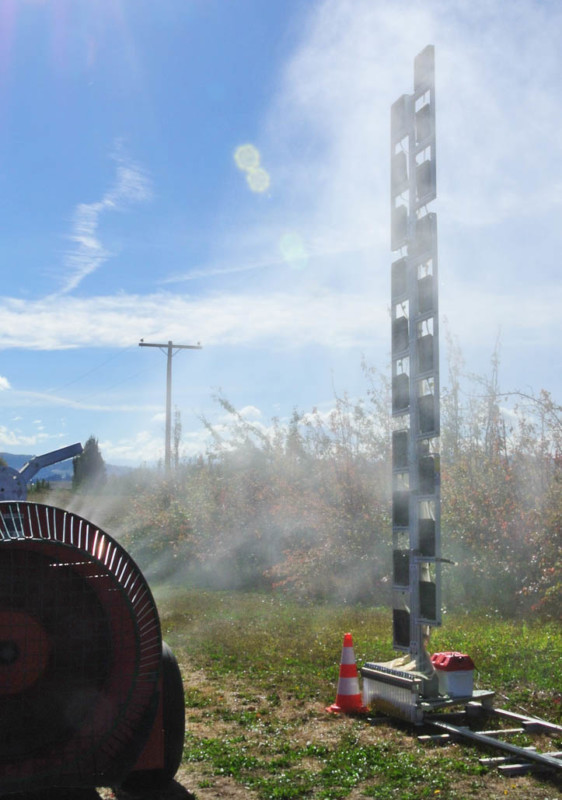
Vertical Patternator- specialized equipment used to determine vertical distribution of output to match orchard canopy. This and other technology such as sensors, donuts, and specialized nozzles help prevent drift, overspray, and waste. Photo Credit: HRSWCSD
In the Middle Columbia region, there has been a remarkably amicable effort since 2000 among growers, the DEQ, the EPA, the Oregon Department of Agriculture, the Confederated Tribes of Warm Springs, and the Hood River Soil and Water Conservation District to reduce the area’s current-use pesticide burden and to keep from exacerbating the legacy problem. Known as the Pesticide Stewardship Partnership (PSP), this cooperative effort has managed to avoid much of the rancor that often poisons the interface between regulators and businessmen. It has also resulted in an overall decline in certain pesticide levels in area waters.
Many growers voluntarily changed their practices. They’ve moved the locations where they mix and pour pesticides into the sprayers away from creeks and even dry ditches and gullies. They’ve timed their applications more carefully based on close observation of pest behaviors and the weather. They’ve committed to using chemicals more as a last resort than a first option.
Since the PSP began, the DEQ’s testing capacity has increased from 15 chemicals to more than 130. And, says Jordan Kim, manager at the Hood River Soil & Water Conservation District, “They can sample for parts per trillion, so they’re finding things they didn’t find before. It’s not that these things weren’t around before, it’s more that now we can see what’s there.” It’s also possible now to take both ‘grab samples’—one-time snapshots—as well as long-term monitoring of concentrations to see when and where pesticides spike and what their average levels are.
Behind the Curve
States are required to report to the EPA every two years on the status of surface waters, and the EPA is behind schedule. For the current proposed 303(d) listing, the most recent data the EPA is relying on is from 2012-2014. For example, chlorpyrifos was measured in Odell Creek in March 2013 at more than twice the EPA benchmark of 41 nanograms per liter (parts per billion). Malathion was measured in Threemile Creek in June 2014 at 1,250 ng/L, about 12 times the benchmark of 100 ng/L.
Mill Creek in The Dalles, already 303(d) listed for malathion, was measured in June 2014 at 1,570 ng/L — nearly 16 times the benchmark. Yet at the same time, in lower Neal Creek, chlorpyrifos declined from an average of more than double the benchmark in 2000 to undetectable in 2012, according to a DEQ PSP report. And in DEQ samples too recent for the EPA to consider (from 2015) taken from Odell Creek, Lenz Creek, and two Neal Creek sites, there was also no chlorpyrifos found at all.
New Pests, New Poisons
We can’t assume that all these improvements in samples mean that the pesticide trend in the Hood River basin will go downward forever. Pests find ways to work around their poisons. And there will always be new pests. And probably new pesticides with new unintended consequences. For example, until the arrival in 2009 of the spotted-wing drosophila, a type of fruit fly from East Asia, growers were tapering off their use of malathion.

Ken Bailey, of Orchard View Farms, a cherry growing operation near The Dalles, says orchardists in his area assumed their usual tactics for Mediterranean fruit flies would work, but they didn’t. Bailey has participated in the Pesticide Stewardship Partnership since about 2001, and praises the program’s willingness to take growers’ needs and experience into account.
For the new fruit fly, Bailey says, “We’ve still not really learned what a good control program is. We’re doing things that maybe we’d rather not.” Currently Orchard View is using malathion and spinosad pesticides to fight all types of fruit fly. Spinosads are derived from bacterial toxins and are allowed in organic agriculture, although they appear to be highly toxic to honeybees, a European bumblebee, and at least one important native Brazilian pollinator. Thus for growers, regulators and the public, pesticide options are often Hobson’s choices – a situation where you are supposed to make a choice but there is no real alternative – and trends can change direction quickly.
Vocal Locals
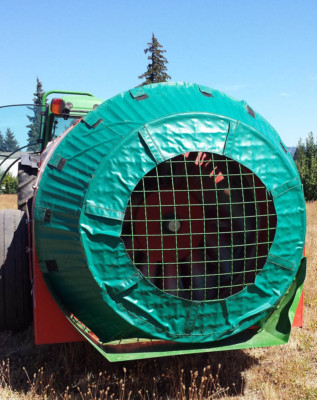
Vinyl “donuts” are low cost retrofits to match sprayer output to orchard canopy. Photo Credit: HRSWCD
DEQ’s Masterson, who has been with the Pesticide Stewardship Partnership from the beginning and is considered by other participants to be an unusual government bureaucrat, because he spends a great deal of time visiting the area and listening to locals, is optimistic because he sees a real community committed to cooperative solutions. He says, “[When the growers] see the data they say, ‘Oh, we didn’t know that. Let’s get some training.’ They always tell us, ‘We fish here, we drink the water.’ They have more of a vested interest in keeping the water clean than anybody.
Adds Bailey, “We are monitoring and trying to work out the best practices to make the most effective use of the chemicals. It’s much better than sitting back and waiting for the DEQ to come by and make you cut back.”
During the Trump presidency there is not likely to be any push from the federal government for more stringent pesticide regulation — chlorpyrifos will stay on the market, for example — but with luck the Pesticide Stewardship Partnership will continue to monitor and reduce pesticide levels in the Hood River drainage based on independent state and regional values.

For further information:
ATSDR Toxicological Profile for malathion
ATSDR Toxicological Profile for chlorpyrifos
Basin Summary Reports. Supplement to the Statewide Water Quality Toxics Assessment Report November 2015. Oregon DEQ
Occurrence and Distribution of Pesticides in Surface Waters of the Hood River Basin, Oregon, 1999 – 2009, USGS
Pesticide Stewardship Partnership Program: Protecting Water Quality through Collaboration. PowerPoint.
Soil and Water District: Water quality listing spurs a history lesson, by Jordan Kim. Hood River News, February 24, 2017.
USEPA: Partial Approval and Partial Disapproval of Oregon 2012 303d List. Cover Letter, Enclosures, and Appendices. Appendix K: Toxics Tab 3, DEQ Analysis
USGS National Map Malathion and Chlorpyrifos use by crop 2014.
RELATED POSTS:




